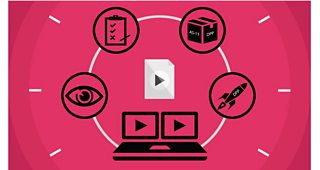College of Technology round up: File delivery
Frederick Botham
Researcher
As I mentioned in , the television industry is currently gearing up for a big change in the way programmes are delivered to broadcasters. For many producers, tape was previously the only way of delivering a TV programme. However, as most productions are now shot and edited digitally, it is clear that programmes need to make the transition to digital delivery too.
The ΒιΆΉΤΌΕΔ Academy has been preparing around this shift to provide a central resource for producers and technical operators alike. From 29th September to 5th October, the Academy is hosting a file delivery takeover week, to coincide with the new AS-11 DPP standard being rolled outΜύtoday as some are calling it). We will be dedicating our homepages to articles and videos to help those in the television industry with this big transition.

File delivery in one graphic
For those new to the subject, ourgives an overview of what exactly the switch to tapeless delivery means and the sort of changes it spells out. In the words of , head of technology for ΒιΆΉΤΌΕΔ HD and UHD, the move to file delivery represents βone of the biggest changes weβve seen in television since colourβ.
One of file deliveryβs big headlines for producers is a reconfiguring of the βquality controlβ (QC) process. A needs to be carried out before the programme is delivered to make sure it is editorially and technically ready to go to air. As broadcasters will only be carrying out spot checks, the ultimate responsibility for sign-off lies with the producer. This review process is two-fold, and requires both an βeyeball QCβ and an automatic quality control (AQC) check. The former involves watching back the final version of the programme, checking the overall quality and consistency by eye and ear, whilst the latter uses software to check for technical issues which would otherwise be hard to spot manually.
For readers eager to try their hand at an eyeball QC test, we have uploaded a real One Show clip which has had editorial and technical faults deliberately added. You can . See how many errors you can pick up on and tweet @TheΒιΆΉΤΌΕΔAcademy to let us know how you get on.
Before, programme tapes were often physically sent off by courier to the broadcaster. Now programmes will be sent from computer to computer, from the edit facility to the broadcaster. The Digital Production Partnership (DPP) has outlined a standard for . This involves wrapping the programme and its corresponding metadata as something called an AS-11 DPP file. When itβs ready to go, the packaged file needs to be sent via a secure link to the broadcaster. This will ideally have a fast upload speed to cope with the large file sizes. An hour-long AS-11 DPP file could be around 50 gigabytes in size. Thatβs a bit too large for a domestic broadband connection if you want to send your file quickly.
For more in-depth details about the file-delivery process we have a series of instructional films based on the File Delivery Made Real tour of events that we organised around the country. In these, you can see the particular processes and tools in action. Our summarises each of these videos, which include: , performing an, , carrying out and .
You can also read this post on the ΒιΆΉΤΌΕΔ R&D blog:
Finally,Μύtoday the College of Production hosted a withΜύpost-production consultant Neil Hatton and the DPPβs Production Technology Lead, Rowan de Pomerai. .
Frederick Botham is a researcher at the ΒιΆΉΤΌΕΔ College of Technology
